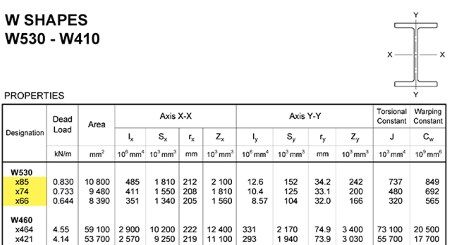Beam/Column and Beam+Column Section Classes per AISC 360 and CSA S16

Description
As you know, the calculations for beams, columns and beams plus columns are based on different equations per AISC 360 and CSA S16. These two worksheets will show you the details about the section classes based on different codes.
The AISC 360 (American Institute of Steel Construction) and CSA S16 (Canadian Standards Association) provide guidelines for classifying steel beam and column sections based on their capacity to resist plastic deformation. Both standards use section classes to categorize cross-sections, but the classification names and criteria differ slightly between them.
AISC 360 Section Classes:
-
Compact Section: A compact section can develop a full plastic moment without local buckling. It has the highest capacity for plastic deformation and is ideal for structures subjected to high bending loads.
-
Non-compact Section: A non-compact section can develop the plastic moment but may experience local buckling before the full plastic moment is reached. It has a reduced capacity for plastic deformation compared to compact sections.
-
Slender Section: A slender section will experience local buckling before it reaches the plastic moment. Slender sections have limited plastic deformation capacity and must be designed using elastic stress analysis.
CSA S16 Section Classes:
-
Class 1: A Class 1 section can form a plastic hinge and fully redistribute the plastic moment under increasing loads without local buckling. It has the highest capacity for plastic deformation.
-
Class 2: A Class 2 section can develop the plastic moment but may experience local buckling before the full plastic moment is reached. The section has a reduced capacity for plastic deformation compared to Class 1 sections.
-
Class 3: A Class 3 section can support loads up to its elastic limit but will experience local buckling before reaching the plastic moment. It has limited plastic deformation capacity.
-
Class 4: A Class 4 section is susceptible to local buckling at stress levels below the elastic limit. It must be designed using elastic stress analysis and has the lowest capacity for plastic deformation.
While the terminology and classification criteria differ between AISC 360 and CSA S16, the underlying concept is the same: categorizing steel sections based on their capacity to resist plastic deformation. Understanding these classifications is crucial for engineers when designing steel structures to ensure the appropriate section is chosen for the intended loading conditions.
Calculation Preview
Full download access to any calculation is available to users with a paid or awarded subscription (XLC Pro).
Subscriptions are free to contributors to the site, alternatively they can be purchased.
Click here for information on subscriptions.


